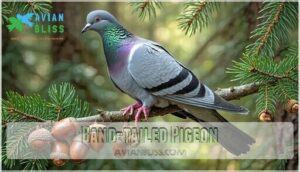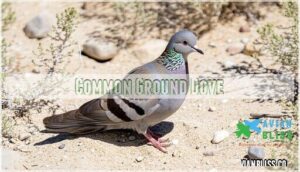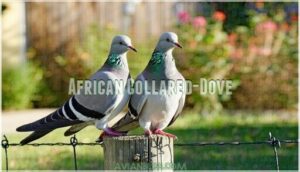This site is supported by our readers. We may earn a commission, at no cost to you, if you purchase through links.
 You’ll spot seven main doves in California, each with distinct features that make identification straightforward.
You’ll spot seven main doves in California, each with distinct features that make identification straightforward.
Mourning Doves are your most common backyard visitors, while Rock Pigeons rule urban areas.
Eurasian Collared-Doves sport black neck bands, and White-winged Doves flash bright wing patches during flight.
Band-tailed Pigeons prefer wooded areas, showing off their namesake tail markings.
Inca Doves and Common Ground Doves stick to Southern California’s warmer regions.
These doves in California adapt to everything from coastal forests to desert scrub, making them accessible for birders at any skill level.
Rare species like Spotted Doves occasionally appear, adding excitement to your birding adventures.
Table Of Contents
- Key Takeaways
- 7 Types of Doves in California
- Rare Doves in California
- Frequently Asked Questions (FAQs)
- Where do mourning doves live in California?
- Are there collared doves in California?
- How many types of doves are there in California?
- What do doves look like in California?
- Are doves a good bird?
- Are doves common in California?
- Is it good to have doves in your yard?
- What does it mean when mourning doves hang around your house?
- Is there a difference between a dove and a Mourning Dove?
- What do California doves eat year-round?
- Conclusion
Key Takeaways
- You’ll find seven main dove species throughout California, from common Mourning Doves in backyards to Band-tailed Pigeons in forested areas, each with distinct identifying features like neck bands, wing patches, or tail markings.
- You can identify doves by their unique calls and physical traits – listen for the Mourning Dove’s "coo-ah, coo, coo, coo" sound, spot the Eurasian Collared-Dove’s black neck collar, or watch for White-winged Doves’ bright wing flashes during flight.
- You’ll spot these birds in diverse habitats across the state, from urban Rock Pigeons thriving in cities to desert-adapted White-winged Doves in Southern California’s warmer regions and ground-dwelling species in scrubby areas.
- You might occasionally encounter rare species like Spotted Doves or African Collared-Doves, though these require careful identification skills to distinguish them from California’s more common dove residents.
7 Types of Doves in California
You’ll find seven distinct dove species throughout California, each with unique features that make identification easier once you know what to look for.
California’s dove diversity offers birdwatchers endless opportunities to spot these graceful, cooing companions in backyards and wild spaces alike.
These birds range from the familiar Mourning Dove with its teardrop eye marking to the tiny Common Ground Dove that’s barely larger than a sparrow.
Mourning Dove
California’s most recognizable dove, the Mourning Dove displays grayish-brown plumage with a pale belly and distinctive black facial dot.
You’ll spot these adaptable birds in parks, backyards, and farmlands across the state.
Their pointed wings create a whistling sound during flight, while their melancholy "coo-ah, coo, coo, coo" vocalizations echo through neighborhoods.
These ground-foraging seed-eaters thrive alongside humans despite ongoing habitat pressures, and they often consume high quality dove seed for nourishment.
Rock Pigeon
Rock pigeons might seem like common city nuisances, but they’re remarkable dove species worth appreciating.
Their plumage variations shimmer with iridescent green and purple neckbands that catch sunlight beautifully.
These California doves showcase incredible urban adaptation, thriving in cities where other birds struggle.
Their famous homing ability has fascinated scientists for decades.
Feral populations feed on diverse diet habits, from seeds to scraps.
They exhibit significant species variations in their plumage.
Look beyond the stereotype—these urban habitats residents display surprising intelligence and grace in dove identification guides.
Eurasian Collared-Dove
You’ll spot the Eurasian Collared-Dove’s signature black neck collar from blocks away.
This dove species arrived from Europe and Asia, showing remarkable urban adaptation across California.
Their grayish-brown plumage and white tail patches make dove identification straightforward.
These California doves demonstrate rapid expansion, often creating native competition with mourning doves.
As an invasive species, their ecological impact raises concerns among researchers.
You’ll hear their rhythmic three-note cooing from rooftops and power lines.
Understanding Eurasian Collared-Dove ID can be enhanced with specialized resources.
Wildlife management strategies now monitor their populations as they continue colonizing urban neighborhoods statewide.
White-winged Dove
You’ll spot the White-winged Dove by its brilliant white wing patches that flash during flight.
This southwestern native measures 10-12 inches and thrives in California’s desert regions through remarkable desert adaptation.
Their migratory patterns bring them north each spring from Mexico.
These dove species excel at fruit consumption, feeding on desert plants they help pollinate.
Whitewinged doves possess impressive mimicry abilities, copying other birds’ calls.
Their distinctive "who-cooks-for-you" song echoes across dove habitats, making birdwatching rewarding.
Many enjoy finding products for dove care to support these amazing birds.
Band-tailed Pigeon
Native bandtailed pigeon populations thrive in California’s mature forest habitat, where these gray doves showcase iridescent neck markings. Their conservation status remains stable despite hunting regulations during specific seasons.
Here’s what makes identification easier:
- Listen for their distinctive "who-cooks-for-YOU" call echoing through trees
- Watch for pale tail bands contrasting against dark flight feathers
- Notice their preference for acorns and pine nuts over typical seeds
- Observe migration patterns as northern birds move south seasonally
These dove species prefer coniferous woodlands over urban bird habitats, requiring bird conservation efforts. Consider pigeon identification products for further assistance, especially for pigeon identification and understanding their migration patterns.
Inca Dove
You’ll recognize the Inca Dove by its scaly appearance and uniformly brown feathers with dark edges.
This small dove species thrives in California’s urban areas, where its soft cooing echoes through neighborhoods at dusk.
- Watch for their charming courtship rituals as males present twigs to potential mates
- Listen for gentle wing-clapping sounds during evening hours
- Notice their habitat preference for gardens, parks, and residential areas
The Inca Dove diet consists mainly of seeds and grains found on sidewalks and lawns. They often forage for specific seed blends to supplement their diet. These adaptable bird species have expanded their range throughout California, making bird identification easier for backyard enthusiasts.
Common Ground Dove
California’s smallest dove species measures just six inches long.
The Common Ground Dove inhabits scrubby areas and grasslands where its dusty brownish-gray plumage provides excellent camouflage techniques against sandy soil.
You’ll spot distinctive chestnut wing patterns when it flushes from cover.
Its habitat preferences include open woodlands and desert edges with sparse vegetation.
Nesting habits involve building simple ground nests hidden among rocks or low shrubs.
Diet composition includes small seeds, grains, and insects.
Listen for its soft "hoo-hoo, hooo, hoo" cooing call.
Products are available featuring this species.
Conservation status remains stable, though habitat loss threatens some populations across their California range.
Rare Doves in California
You’ll occasionally spot two rare dove species that aren’t part of California’s regular seven-species lineup.
The Spotted Dove and African Collared-Dove represent uncommon sightings that require careful identification skills to distinguish from their more common relatives.
Spotted Dove
You’ll rarely encounter the Spotted Dove in California today, though they once called this state home.
Their distinctive identification collar – a black neck band with white spots – makes them unmistakable when spotted.
They’re also found in coastal Hawaiian habitats.
- Originally introduced from South and Southeast Asia in 1917
- Black collar with fine white spotting creates unique identification collar
- Prefer open farmland adaptation over dense urban environments
- Population experiencing significant Spotted Dove decline in recent decades
- Conservation efforts needed to prevent local extinction
- Habitat preferences include agricultural areas and open countryside
African Collared-Dove
Spotting an African Collared-Dove in California feels like finding a needle in a haystack. This pale buff-colored dove with its distinctive black neck crescent rarely appears in the wild here.
You’ll face identification challenges distinguishing it from the similar Eurasian Collared-Dove – look for white undertail coverts and lighter wingtips. Most sightings involve escaped pets from urban habitats rather than wild populations.
While their conservation status remains stable in native Africa, these potential invasive species could impact local ecosystems. The African collared dove, scientifically known as Streptopelia roseogrisea, is the wild ancestor of the domestic Barbary dove.
Your bird identification guide skills help monitor this rarity in California’s diverse avian landscape.
Frequently Asked Questions (FAQs)
Where do mourning doves live in California?
You’ll find mourning doves practically everywhere in California—they’re the ultimate homebodies who’ve mastered suburban living.
These adaptable birds thrive in farms, neighborhoods, open woodlands, and even desert areas throughout the state, making them a widespread presence due to their ability to be adaptable.
Are there collared doves in California?
Yes, you’ll find two collared dove species in California.
The Eurasian Collared-Dove thrives statewide with its distinctive black neck collar, while the African Collared-Dove remains rare but occasionally spotted by dedicated birders.
How many types of doves are there in California?
California hosts seven dove and pigeon species that you’ll encounter across the state.
You can spot Mourning Doves, Rock Pigeons, Eurasian Collared-Doves, White-winged Doves, Band-tailed Pigeons, Inca Doves, and Common Ground Doves in various habitats.
What do doves look like in California?
Delightful doves display diverse appearances you’ll recognize easily.
You’ll spot gray-brown mourning doves with pointed tails, white-winged doves showing bright wing patches, tiny ground doves with scaly feathers, and collared doves wearing distinctive black neck bands.
Are doves a good bird?
Doves make excellent birds for you to enjoy.
They’re peaceful, gentle creatures that bring tranquility to your backyard.
You’ll love their soft cooing sounds and graceful flight patterns throughout the day.
Are doves common in California?
Picture feathered residents dotting power lines and city parks across the Golden State.
You’ll spot seven dove species throughout California, from bustling urban centers to quiet desert landscapes, making them quite common and easily observable year-round.
Is it good to have doves in your yard?
Yes, having doves in your yard is beneficial.
They’re peaceful, eat weed seeds, and won’t damage plants.
Their gentle cooing creates a calming atmosphere while they help control unwanted vegetation naturally.
What does it mean when mourning doves hang around your house?
When mourning doves gather around your house, they’ve likely found reliable food sources, water, or safe nesting spots.
You’re providing what they need—seeds, shelter, and security—making your property their preferred habitat.
Is there a difference between a dove and a Mourning Dove?
All doves are types of pigeons, but you’ll recognize mourning doves by their specific features: pointed tails, grayish-brown color, and distinctive "coo-ah, coo, coo, coo" call that sets them apart.
What do California doves eat year-round?
California’s doves feast on seeds, grains, fruits, and insects throughout the year.
You’ll find them foraging on ground for grass seeds, berries, and small invertebrates, adapting their diet to seasonal availability.
Conclusion
California’s skies serve as a living gallery where doves in California paint their stories across diverse landscapes.
You’ve now got the tools to identify seven common species plus rare visitors that occasionally grace the state.
From urban Rock Pigeons to elusive Band-tailed Pigeons in forests, each species offers unique identification markers.
Practice recognizing their distinctive calls, flight patterns, and preferred habitats.
With patience and these identification tips, you’ll confidently distinguish between California’s remarkable dove species during your next birding adventure.











